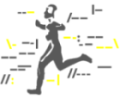





Search | Sitemap | Navigation |  |
|
||||||||||||||||||||||||||
|
||||||||||||||||||||||||||
|
||||||||||||||||||||||||||
|
The psychological experience of migraine aura
Migraine auras experienced by children
Migraine auras occur in 10-15% children with migraine. Visual auras are the most common and often frightening. They may consist of visual loss, flashing lights or squiggly lines, likened by some kids to "flashy christmas lights", "millions of coloured bugs everywhere" or even "a 'real' ghost". It is suggested that children with a diagnosis of migraine headaches should be told about migraine auras so they don't get scared if they ever get it. [Pending]
Negative emotional and cognitive reactions
Especially to the uninitiated sufferer, the migraine aura may represent a hellish experience arousing fears of going blind, having a brain tumour or stroke, becoming insane or even dying. Other negative emotional and cognitive reactions may be induced by the migraineur's awareness of disability (e.g. during work or whilst car driving) and social stigmatization resulting from the migraine aura. Some may wish to die at the height of the migraine attack. Gaining knowledge about the migraine aura may help the sufferer to develop a coping strategy, accepting the aura as a part of everyday life that loses many if not all aspects of its threatening character. [Pending]
Positive emotional and cognitive reactions
It is far less well known that the beauty of the migraine aura, especially when it occurs without headache, may also offer visions of heaven. According to the words of one migraineur, the aura is truly Nature's Wonderland of visual effects, sometimes assuming the character of a deep spiritual experience. [Pending]
Mystical interpretations
In his study The varieties of religious experience, American psychologist and pragmatist William James described four phenomenal criteria which can be used to characterise a mystical state of mind, i.e. (1) its ineffability, (2) noetic quality, (3) transiency and (4) passivity. Except for the noetic quality which is rare, these criteria are common features of the migraine aura experience. Darren Aronofsky's film Pi (1997) is an outstanding artistic work exemplifying a migraine sufferer's mystical state of mind. [Pending]
Religious interpretations
The phenomena of migraine aura have been suggested as the basis of religious visions of the Apostle Paul, Hildegard of Bingen and Blaise Pascal. The internet provides many records of religious interpretations of migraine aura experiences from contemporary migraine sufferers. [Pending]
Magical interpretations
Magical interpretations of migraine aura phenomena are not only suggested by historical records, e.g. in the case of Giorgio de Chirico, but also by numerous testimonies from contemporary internet users who may (at least in some cases) mistakenly attribute migraine aura symptoms to effects exerted by black or white magic. [Pending]
Migraine aura symptoms and psychic experiences
Some migraine aura symptoms bear a remarkable phenomenal similarity to certain so-called paranormal or psychic experiences such as ghost or fairy visions, reading "aura", precognition, astral projection and others. To learn more about possible relationships between such migraine aura phenomena (e.g. visual hallucinations, corona phenomenon, déjà vu, out-of-body experiences) and psychic experiences click here. [Pending]
Anthropomorphic interpretations
Migraineurs may liken the geometric patterns of the visual aura hallucinations to human or human-like forms, creating metaphors that help express and communicate their subjective visual sensations. [Pending]
Zoomorphic interpretations
The animal kingdom provides many more metaphors suitable to describe the shapes of visual aura hallucinations, giving rise to a Migraine Aura Bestiary of which Lewis Carroll's Cheshire Cat is the most popular specimen. [Pending]
Migraine and creativeness
Some migraineurs may benefit from a sort of generally increased creativeness before, during or after the headache phase of a migraine attack, manifesting itself not only in artistic endeavours or writing, but in all fields of thinking requiring problem solving. The output of this temporarily increased creativity associated with migraines is usually unrelated to the features of any aura phenomena that may be present. However, as can be seen at an elementary level in the act of creating metaphors for the visual hallucinations of migraineurs, aura experiences (e.g. the visual patterns occuring in hallucinations) may also act as a specific source of artistic inspiration, as demonstrated by studies based on Derek Robinson's concept of Migraine Art. [Pending]
References
Lippman CW, Lippman M. Understanding Your Migraine Headache. Greenberg Publisher, New York 1952.
Sacks OW. Migraine. Revised and expanded. University of California Press, Berkeley-Los Angeles-Oxford 1992.
Author: Klaus Podoll
Last modification of this page: Monday August 22. 2005
 Top of the page
Top of the page| · | News |
| · | Medical Professionals |
| · | Medical Studies |
Copyright © 2005 Migraine Aura Foundation, All rights reserved. Last modification of this site: August 25, 2006
Thanks to: RAFFELT MEDIENDESIGN and GNU software | webmaster@migraine-aura.org
http://migraine-aura.org/EN/Psychological_experience.html


